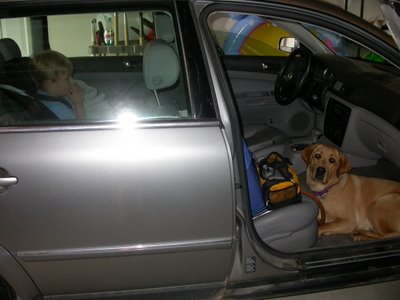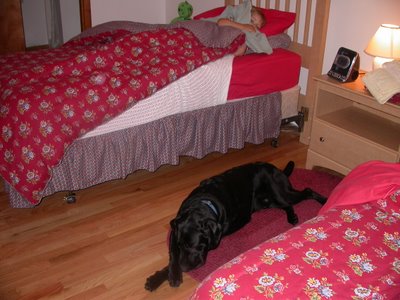Here is the final report on Lance's training ... as far as we know, he's supposed to graduate later this month!
What a dog! Just read what these guys have to learn and do. It's really incredible!
GUIDING EYES FOR THE BLIND
TRAINING REPORT – PHASE FOUR
Dog Name Lance Tattoo XXXXX Raiser's Name Nina/Patricia
Report Dates 5-18-06 Trainer's Name Kate B.
For some dogs, the fourth phase follows directly after a month of training in the third phase. For many dogs,
however, the third phase may take many months or the dog may begin to show worry indicating a need to return to
more basic lessons or a quieter environment where the dog is comfortable. Each dog learns at its own pace and must
demonstrate a reliable work pattern before it can be asked to handle a more difficult environment or more
responsibility.
The fourth phase is a time for fine-tuning and also a time for applying learned lessons to new situations. For
example, they are taught to handle traffic when crossing the road. You can understand how important it is for the
dog to understand curb stops which indicate the road and to make quick straight street crossings in order to find the
opposite corner before learning to intelligently disobey a forward command to cross the street if a car is coming or
to stop and back up if a car suddenly appears in their path.
By the end of phase four, the dog must demonstrate the initiative to take responsibility in all guiding situations.
They must perform reliably and safely each time. There is a tremendous amount of pressure on the dog to be a
responsible guide dog. Think of it in terms of driving a car. You might have felt comfortable driving your car on
the quiet streets in your town but in New York City where there is so much to watch for, you may feel less
comfortable and will likely be a bit stressed. After experience and, hopefully, successful trips driving in the city,
you will eventually begin to relax and feel more confident. Some dogs thrive on the excitement and challenge of
this type of work, others can handle it but not as a steady diet. How they handle the intense pressure of city work,
helps the instructors decide where the dog will be placed.
Health ( X ) Has been healthy Has had a health problem.
Physical - This is often called the “pre-class physical.” It does not mean your dog will definitely be
selected for class but is the time that the dog receives a thorough re-exam of the eyes, heart and other body
systems and a review of the complete medical history to be sure the dog passes our stringent health criteria.
Dentistry – Each dog also gets a dental check up and gets his teeth cleaned and polished if necessary
Notes on health:
General kennel behavior: No problem. Needs some work.
Your dog continues to enjoy community run twice daily, five days a week and continues the work with the instructor
assistant on body handling including nail cutting, grooming, and ear cleaning.
Notes on general kennel behavior:
TrainingThis is the most advanced stage of training. All lessons previously taught are solidified and applied to new
situations and the dog is also taught new lessons. Your dog will most likely work in some of these places: New
York City including Manhattan and the Bronx for city experience and subway work, Peekskill for uneven sidewalks,
White Plains for many applications, country roads without sidewalks around Yorktown and in the Training School
building and restaurants for good social skills.
(P:Poor F:Fair G:Good F/G:Fair/Good, etc. ) Being worked on.
G Steady pace and pull.
G Turns, down curbs and street crossings, clearances, platforms, escalators, revolving doors, stairs, Stores
and malls.
Remedial problems being worked on to build confidence or obtain proper response in situations such as
stairs, under-footings, control with distractions, concerns with noises, people or objects, over-friendliness,
etc. (See Notes.)
G Blindfold work – The dogs are tested for their reliability by being worked by a blind-folded instructor.
Blindfold work was also done in phase three to identify weak areas that needed to be worked on but there
are more blindfold workouts in phase four.
G Subway and city work – Every Guiding Eyes dog must demonstrate the ability to guide safely in the city
and in subways and on all types of transportation before they are ready to graduate. This environment
really tests the dog’s self-confidence, composure and ability to guide. Pedestrian traffic poses the extreme
in moving obstacles, the traffic is so heavy that a sighted person has a challenge finding a safe time to
cross the street. The subway is a noisy and intimidating environment where crowded cars and people
rushing on the platforms are commonplace.
G Traffic – Phase I - The dogs are taught the appropriate response of backing up when a car get too close.
The lessons begin on quiet sidewalks with a car pulling in or out of a driveway. When the dog backs up
in a straight backwards direction, the handler is also moved backward, away from the oncoming car.
Since the dogs work slightly ahead of the handler when in harness, the person remains safe. As with
other lessons, the dogs are shown how to back up when a car is driven slowly toward them. Their first
tendency is to turn away from the vehicle rather than to back up, but they usually catch on quickly.
Traffic training is very stressful to the dog and many dogs worry with other aspects of their guide work
after traffic training sessions. Some dogs need a little vacation from training or have the intensity of their
training reduced if their worry is severe.
G Traffic Phase II -- Once the guide dog demonstrates the appropriate response to traffic, the dog is
expected to react appropriately on its own when a car comes too close. Vehicles driven by GEB trainers
display special signs reading “TRAFFIC TRAINING” to inform the public that the handler is not rudely
run down by a crazy driver. The dog is exposed over and over to varied situations where a car comes in
close from various directions and different turns such as driveways, roadways, crossings, etc.
G Traffic Phase III – The final phase of traffic training involves natural traffic and real situations. The
handler waits at a crossing until the perpendicular traffic has stopped and the parallel traffic begins
moving. When the handler does not hear any oncoming parallel traffic, the dog is given the forward
command. If a car is coming, the dog is reminded not to go. Eventually, the dog learns to disobey a
forward command when a car is coming. The response of backing up when natural traffic gets too closed
is also reinforced during phase III traffic training.
G Shorelining on a country road -- Blind people and guide dogs living in the country where there are no
sidewalks. They find it difficult to stay close to the edge of the road and much move off the road when
cars are coming since they are actually traveling on the side of the road. Shorelining teaches the dog to
move tightly to the edge of the road and to stop when a car is coming.
G Practice Dog for a student -- When your dog is in the fourth phase of training, he is not too far away from
being “class-ready” or, in other words, deemed to be a reliable guide and ready for matching with a blind
person. Students entering class are given an opportunity to work with guide dogs that are in the fourth
phase of training but not yet class ready. Your dog may be selected as a practice dog. Practice dogs give
the blind person a chance to learn the basics of handling a guide dog without the risk of straining the
relationship with the dog that they are going to be matched to. It also gives the instructors a chance to
evaluate the student with a dog and make a more informed match. For the dog, it gives the instructors,
who are preparing the fourth phase dogs for an upcoming class a chance to see how the dog reacts to the
real situation of a blind handler.
G Restaurants and social settings – Similar to puppy raising, guide dogs must lie down quietly in restaurants
and public places. The work you did is evident in all aspects of training and especially here. The
instructors greatly appreciate the good manners you have instilled.
Notes on training and reaction to the environment:Lance has progressed very well through training. This past training period, he has polished his
guide work skills in many different towns and cities, including New York City. He is well-behaved in
all settings and works well in all environments. Last week Lance had his final blindfold evaluation.
The evaluator wrote that Lance is a "Lovely tempered dog that is a methodical worker. Well
established work pattern. Nice dog for a variety of clients. Good initiative and problem solving
skills." Way to go, Lance! He is definitely a candidate for the upcoming class.
Each stage of training with Lance has been a pleasure. Now that he is finished with training and is
responsible for working on his own, it is very enjoyable to go on long workouts with him, where he
deals with many different situations with intelligence and aplomb. I will miss his great work, his
good humor and his fuzzy neck, but (should a good match for him come in ) he should make a
wonderful guide.
Puppy Evaluator Date
cc:


